Improved Locating Method for Local Defects in XLPE Cable Based on Broadband Impedance Spectrum
Abstract
1. Introduction
2. BIS Algorithm
2.1. Transmission Line Model
2.2. BIS Algorithm
2.3. The selection of Gaussian Signal
2.4. The Process of Time–Frequency Transformation
2.5. Location of Reflected Peaks
3. Results and Discussion
3.1. Experimental Setup
3.2. Location Spectra of Samples
3.3. Locating Results of Abrasion and Nail Insertion
4. Conclusions
- The pulse width parameter c of the Gaussian signal is determined by the upper limit frequency of BIS. The proper c will improve the locating resolution.
- The location spectrum can locate mechanical abrasion and an inserted nail in a 20 m cable. The location of the abrasion shows two reflected peaks, and the location of the inserted nail shows a single reflected peak.
- In the location of abrasion, the deviation is within 1%. The centroid and function fitting methods can effectively reduce the positioning error.
- When the depth of the nail insertion is small, the locating deviation is within 1%. The centroid method and function fitting method can reduce the locating error. When the nail insertion depth is greater, the absolute value of the deviation will be more significant, and the maximum absolute value is 4%.
Author Contributions
Funding
Institutional Review Board Statement
Informed Consent Statement
Data Availability Statement
Conflicts of Interest
References
- Rybarz, J.; Borucki, S.; Kunicki, M.; Kucińska-Landwójtowicz, A.; Wajnert, D. Influence of the Cable Accessories Installing Method on the Partial Discharge Activity in Medium Voltage Cables. Energies 2022, 15, 4216. [Google Scholar] [CrossRef]
- Diban, B.; Mazzanti, G. The Effect of Insulation Characteristics on Thermal Instability in HVDC Extruded Cables. Energies 2021, 14, 550. [Google Scholar] [CrossRef]
- Shahid, M.; Khan, T.; Zafar, T.; Hashmi, M.; Imran, M. Health diagnosis scheme for in-service low voltage Aerial Bundled Cables using super-heterodyned airborne Ultrasonic testing. Electr. Pow. Sys. Res. 2020, 180, 106162. [Google Scholar] [CrossRef]
- Zhang, Y.; Li, T. Fault location for overhead and cable hybrid transmission lines based on the difference quantities of forward propagating waves and backward propagating waves in HVDC systems. Electr. Pow. Sys. Res. 2022, 203, 107642. [Google Scholar] [CrossRef]
- Li, G.; Liang, X.; Zhang, J.; Li, X.; Wei, Y.; Hao, C.; Lei, Q.; Li, S. Insulation Properties and Interface Defect Simulation of Distribution Network Cable Accessories Under Moisture Condition. IEEE Trans. Dielectr. Electr. Insul. 2022, 29, 403–411. [Google Scholar] [CrossRef]
- Shan, B.; Li, S.; Yu, L.; Wang, W.; Li, C.; Meng, X. Effect of Segmented Thermal Aging on Defect Location Accuracy in XLPE Distribution Cables. IEEE Access 2021, 9, 134753–134761. [Google Scholar] [CrossRef]
- Ning, Y.; Wang, D.; Li, Y.; Zhang, H. Location of Faulty Section and Faults in Hybrid Multi-Terminal Lines Based on Traveling Wave Methods. Energies 2018, 11, 1105. [Google Scholar] [CrossRef]
- Baayeh, A.G.; Bayati, N. Adaptive Overhead Transmission Lines Auto-Reclosing Based on Hilbert–Huang Transform. Energies 2020, 13, 5416. [Google Scholar] [CrossRef]
- Cataldo, A.; de Benedetto, E.; Masciullo, A.; Cannazza, G. A New Measurement Algorithm for TDR-based Localization of Large Dielectric Permittivity Variations in Long-distance Cable Systems. Measurement 2021, 174, 109066. [Google Scholar] [CrossRef]
- Cheng, B.; Hua, L.; Zhu, W.; Zhang, Q.; Lei, J.; Xiao, H. Distributed Temperature Sensing with Unmodified Coaxial Cable based on Random Reflections in TDR Signal. Meas. Sci. Technol. 2018, 30, 015105. [Google Scholar] [CrossRef]
- Addad, M.; Djebbari, A. Simultaneous Multiple Cable Fault Locating using Zero Correlation Zone Codes. IEEE Sens. J. 2021, 21, 907–913. [Google Scholar] [CrossRef]
- Addad, M.; Djebbari, A. Spread Spectrum Sensing Based on ZCZ Sequences for the Diagnosis of Noisy Wired Networks. IEEE Sens. J. 2021, 21, 914–920. [Google Scholar] [CrossRef]
- Bittner, T.; Bajodek, M.; Bore, T.; Vourc’h, E.; Scheuermann, A. Determination of the Porosity Distribution during an Erosion Test Using a Coaxial Line Cell. Sensors. 2019, 19, 611. [Google Scholar] [CrossRef] [PubMed]
- Shi, X.; Liu, Y.; Xu, X.; Jing, T. Online Detection of Aircraft ARINC Bus Cable Fault Based on SSTDR. IEEE Syst. J. 2021, 15, 2482–2491. [Google Scholar] [CrossRef]
- Berger, W.; Furse, C. Spread Spectrum Techniques for Measurement of Dielectric Aging on Low Voltage Cables for Nuclear Power Plants. IEEE Trans. Dielectr. Electr. Insul. 2021, 28, 1028–1033. [Google Scholar] [CrossRef]
- Hu, S.; Wang, L.; Mao, J.; Gao, C.; Zhang, B.; Yang, S. Synchronous Online Diagnosis of Multiple Cable Intermittent Faults Based on Chaotic Spread Spectrum Sequence. IEEE Trans. Ind. Electron. 2019, 66, 3217–3226. [Google Scholar] [CrossRef]
- Edun, A.; Tumkur Jayakumar, N.; Kingston, S.; Furse, C.; Scaepulla, M.; Harley, J. Spread Spectrum Time Domain Reflectometry With Lumped Elements on Asymmetric Transmission Lines. IEEE Sens. J. 2021, 21, 921–929. [Google Scholar] [CrossRef]
- Kim, H.; Park, J.; Mun, J.; Kim, D.; Hwangbo, S.; Yi, D.; Byun, J. Sensitivity Analysis of Water Tree and Input Pulse Parameters for Time-Domain Reflectometry of Power Cables Using Taguchi Method. J. Electr. Eng. Technol. 2021, 16, 633–642. [Google Scholar] [CrossRef]
- Tang, Z.; Zhou, K.; Meng, P.; Li, Y. A Frequency-Domain Location Method for Defects in Cables Based on Power Spectral Density. IEEE Trans. Instrum. Meas. 2022, 71, 1–10. [Google Scholar] [CrossRef]
- Yamada, T.; Hirai, N.; Ohki, Y. Improvement in Sensitivity of Broadband Impedance Spectroscopy for Locating Degradation in Cable Insulation by Ascending the Measurement Frequency. In Proceedings of the 2012 IEEE International Conference on Condition Monitoring and Diagnosis, Bali, Indonesia, 23–27 September 2012; pp. 677–680. [Google Scholar] [CrossRef]
- Ohki, Y.; Hirai, N. Comparison of Location Abilities of Degradation in a Polymer-Insulated Cable between Frequency Domain Reflectometry and Line Resonance Analysis. In Proceedings of the 2016 IEEE International Conference on High Voltage Engineering and Application (ICHVE), Chengdu, China, 19–22 September 2016; pp. 1–4. [Google Scholar] [CrossRef]
- Cao, Y.; Meng, P.; Zhou, K.; Jin, Y.; Zhou, T.; Yang, J.; Wu, W. Defects Location of Multi-Impedance Mismatched of Power Cables Based on FDR Method with Dolph-Chebyshev Window. In Proceedings of the 2011 22nd International Symposium on High Voltage Engineering (ISH 2021), Xi’an, China, 21–26 November 2011; pp. 1810–1815. [Google Scholar] [CrossRef]
- Scarpetta, M.; Spadavecchia, M.; Adamo, F.; Ragolia, M.A.; Giaquinto, N. Detection and Characterization of Multiple Discontinuities in Cables with Time-Domain Reflectometry and Convolutional Neural Networks. Sensors 2021, 21, 8032. [Google Scholar] [CrossRef]
- Ohki, Y.; Hirai, N. Effects of the Structure and Insulation Material of a Cable on the Ability of a Location Method by FDR. IEEE Trans. Dielectr. Electr. Insul. 2016, 23, 77–84. [Google Scholar] [CrossRef]
- Ohki, Y.; Hirai, N. Location Attempt of a Degraded Portion in a Long Polymer-Insulated Cable. IEEE Trans. Dielectr. Electr. Insul. 2018, 25, 2461–2466. [Google Scholar] [CrossRef]
- Zhang, H.; Mu, H.; Zou, X.; Zhang, D.; Zhang, G.; Xie, C. A Novel Method for Identifying Cable Defect and Improving Location Accuracy Based on Frequency Domain Reflectomerty. In Proceedings of the 2021 IEEE 4th International Electrical and Energy Conference (CIEEC 2021), Wuhan, China, 28–30 May 2021; p. 9510503. [Google Scholar] [CrossRef]
- Md Thayoob, Y.; Mohd Ariffin, A.; Sulaiman, S. Analysis of High Frequency Wave Propagation Characteristics in Medium Voltage XLPE Cable Model. In Proceedings of the 2010 International Conference on Computer Applications and Industrial Electronics (ICCAIE), Kuala Lumpur, Malaysia, 5–8 December 2010; pp. 665–670. [Google Scholar] [CrossRef]
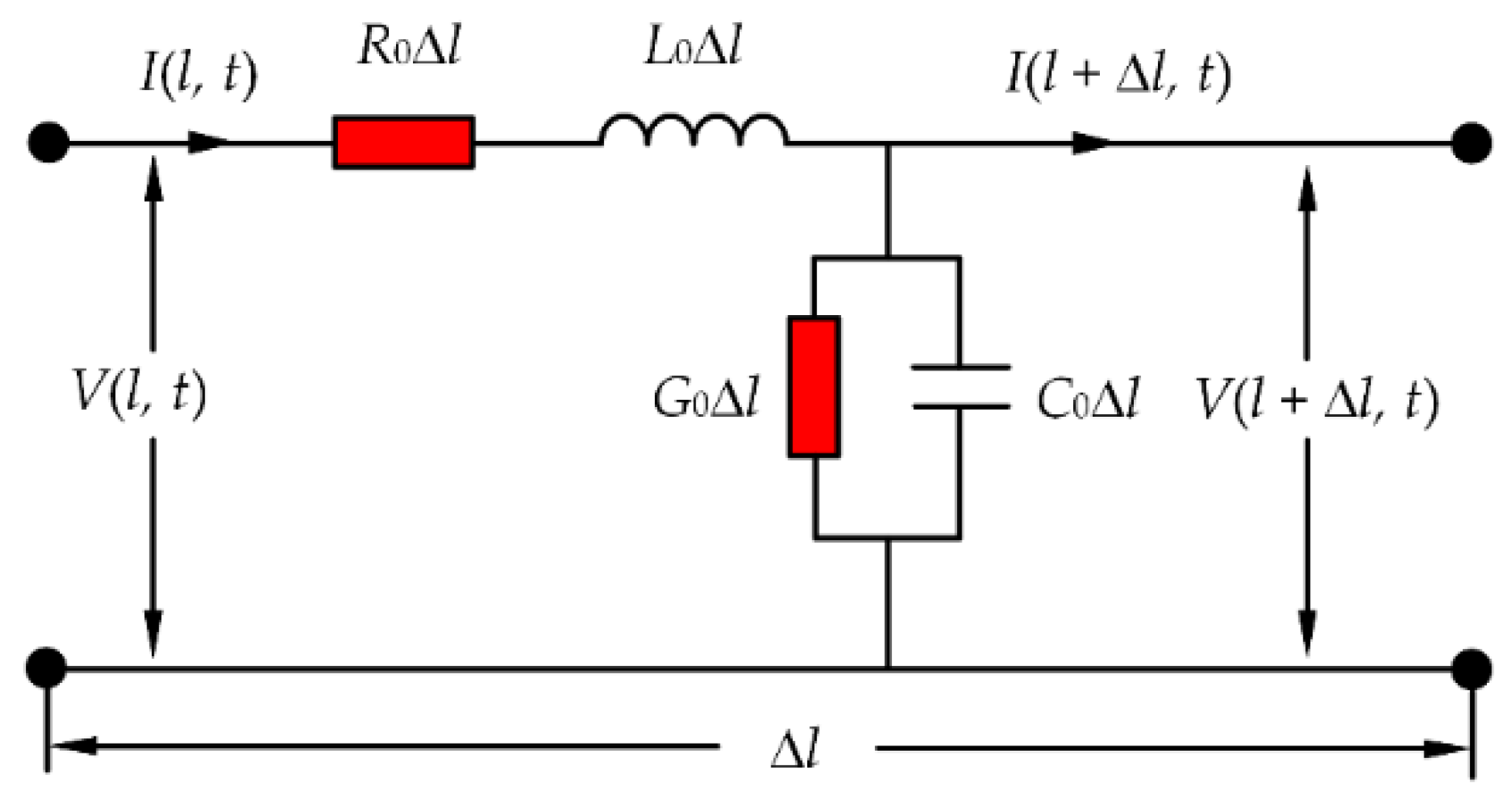
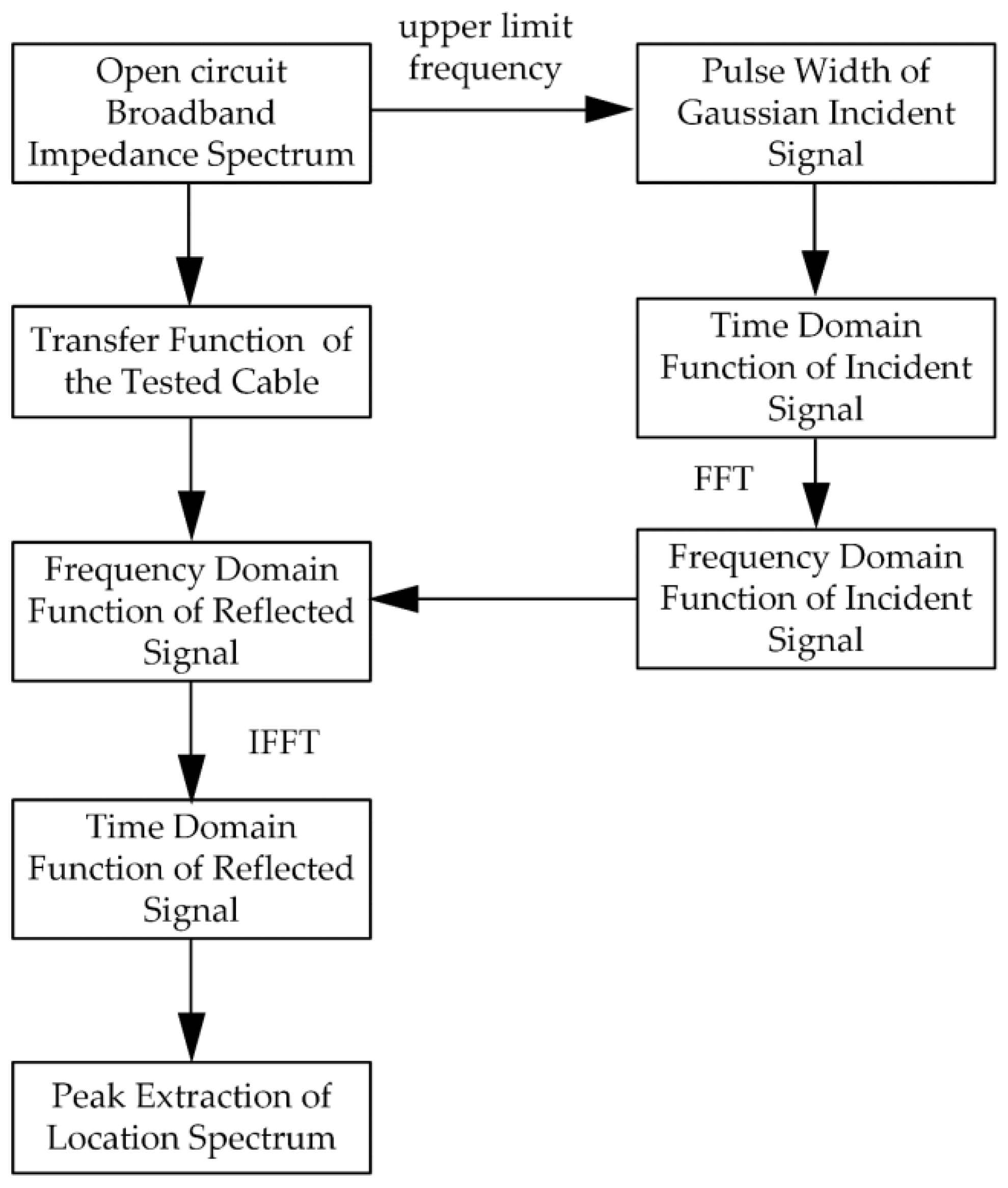
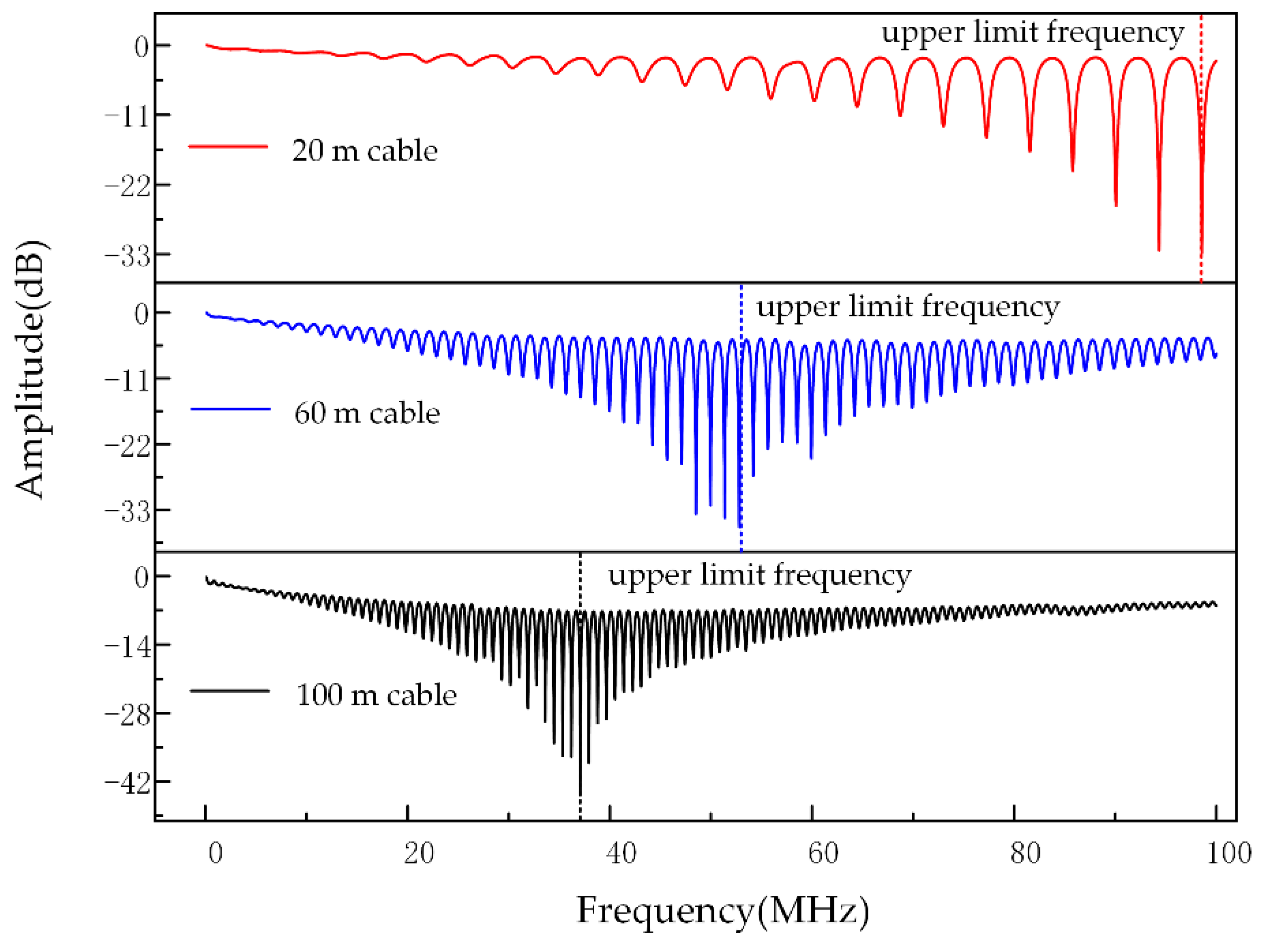
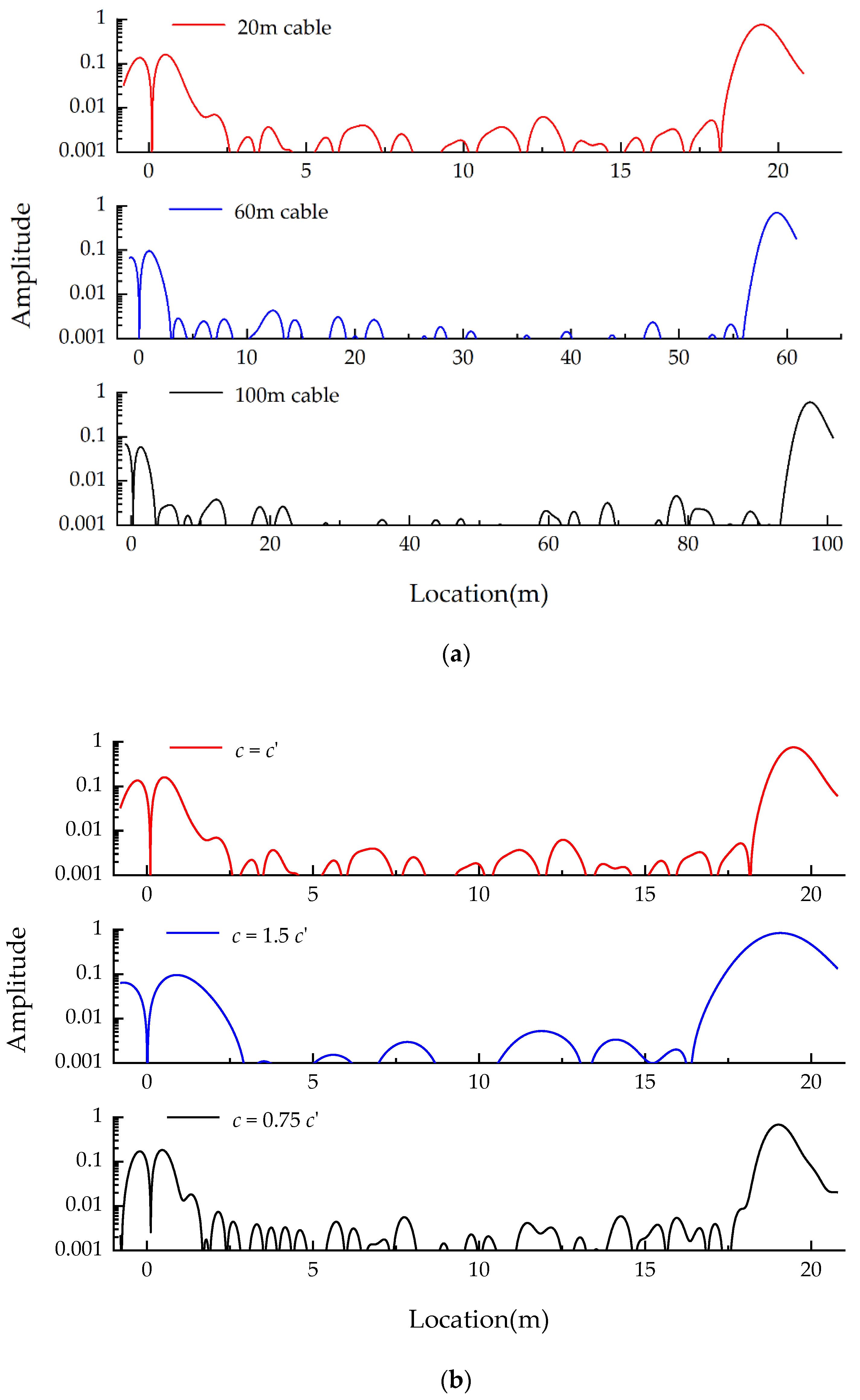
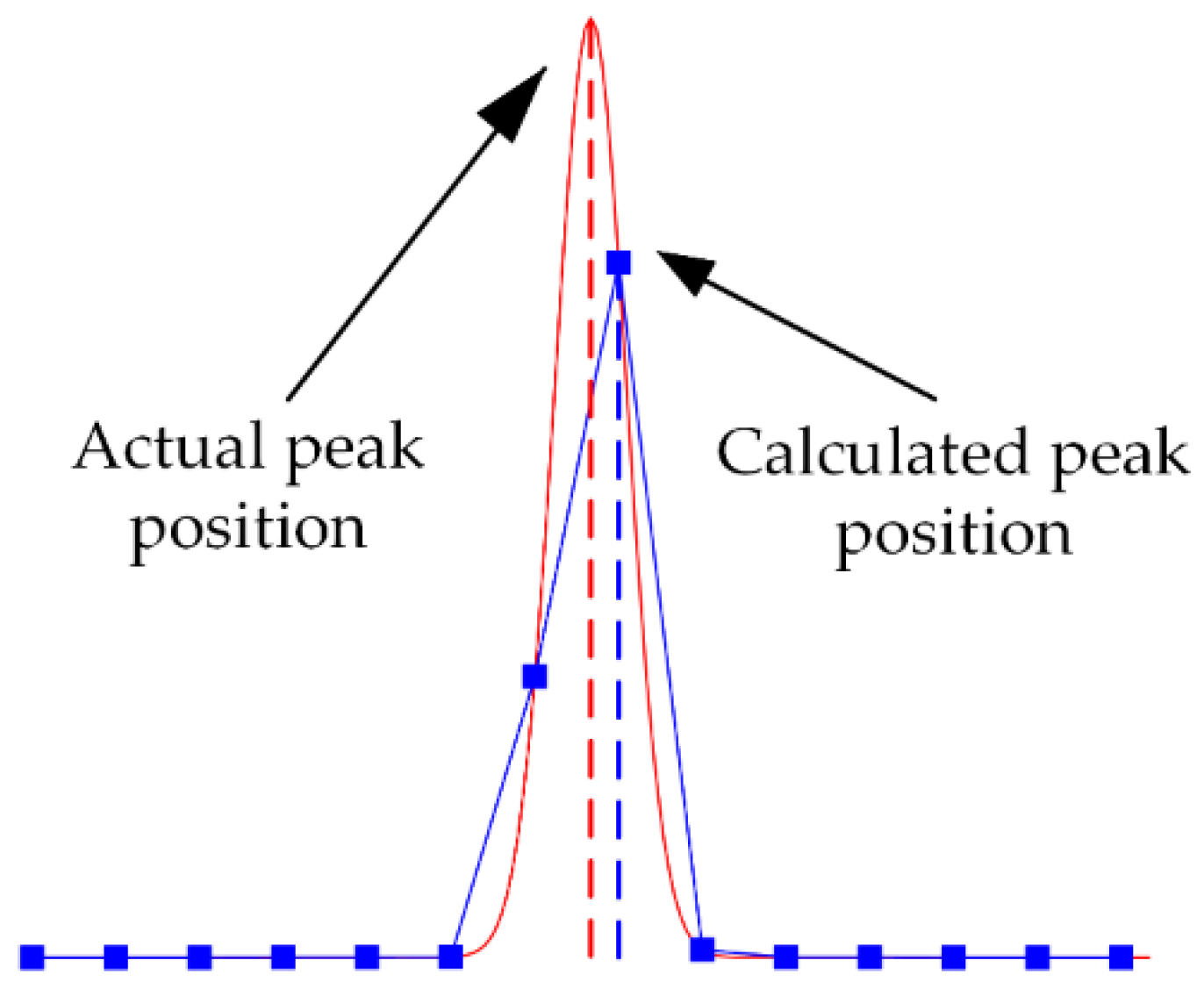
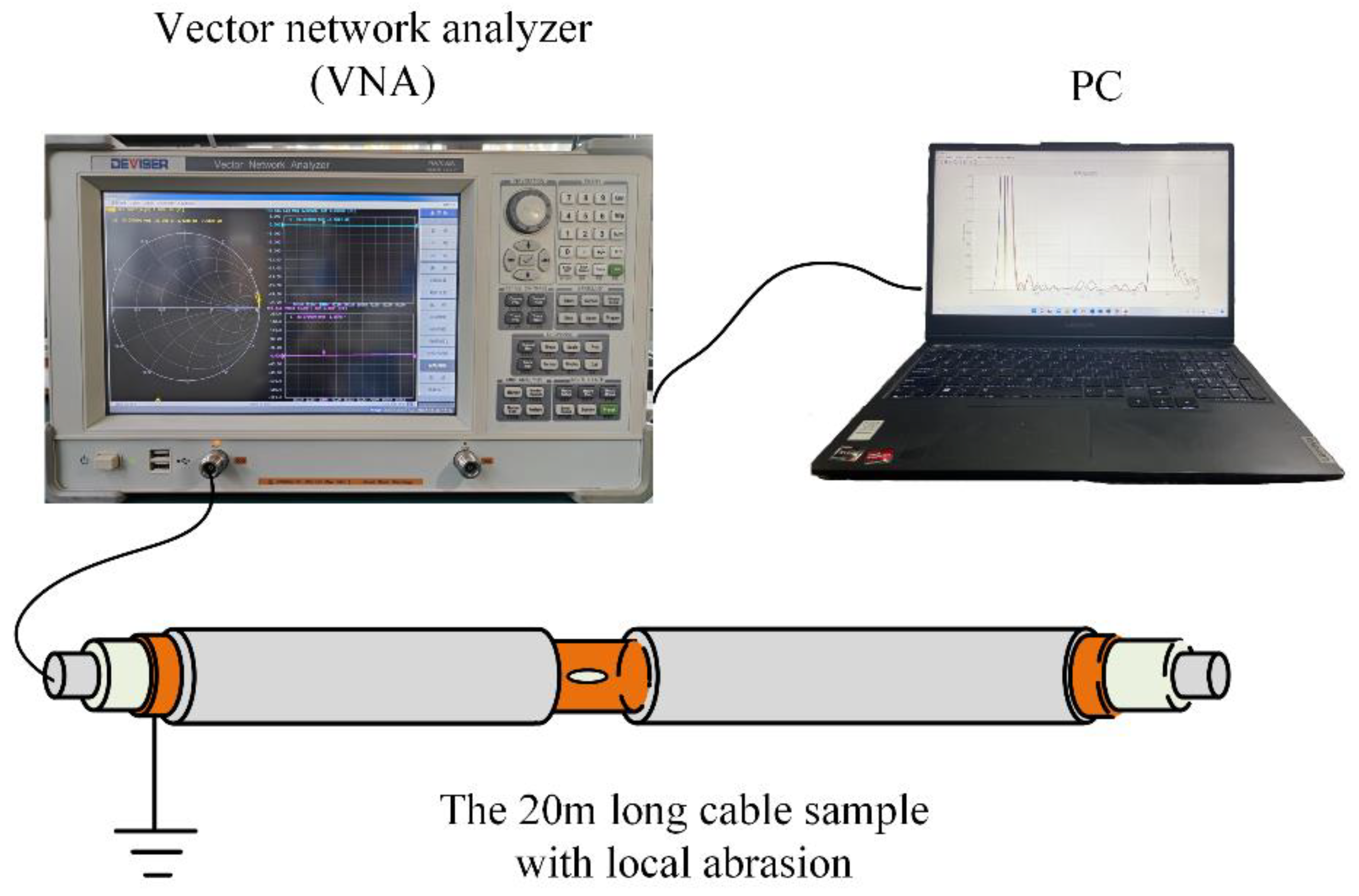
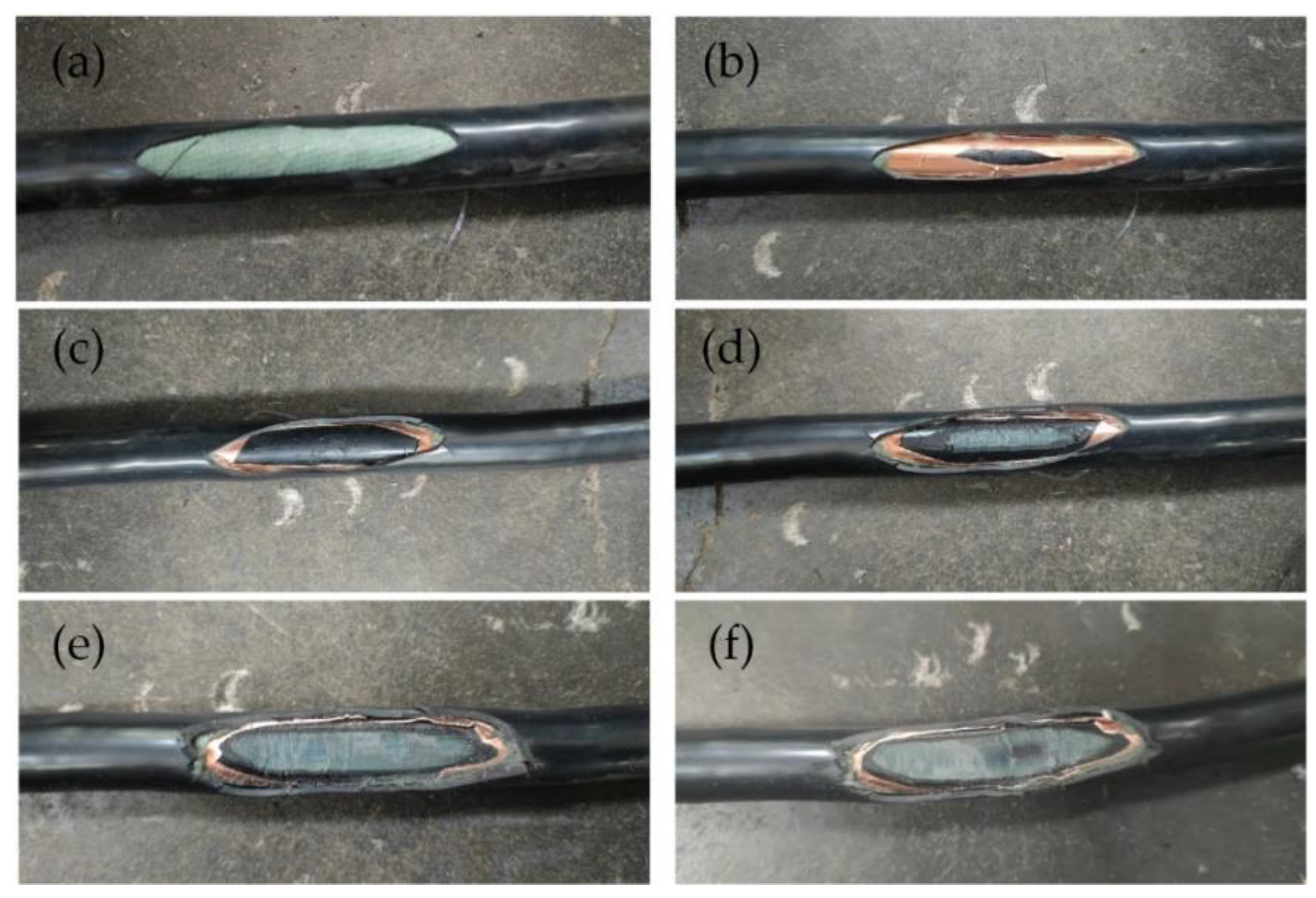
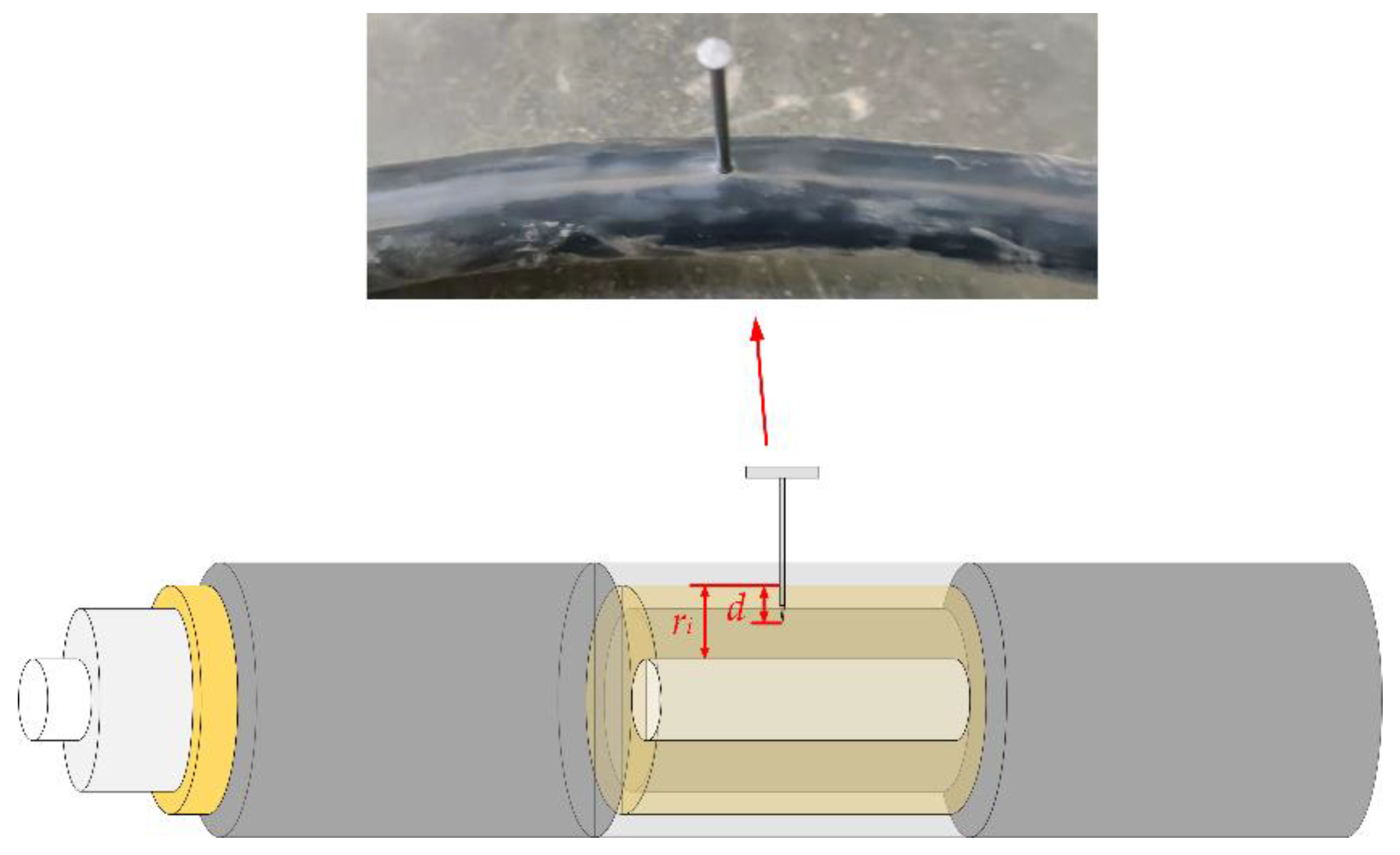
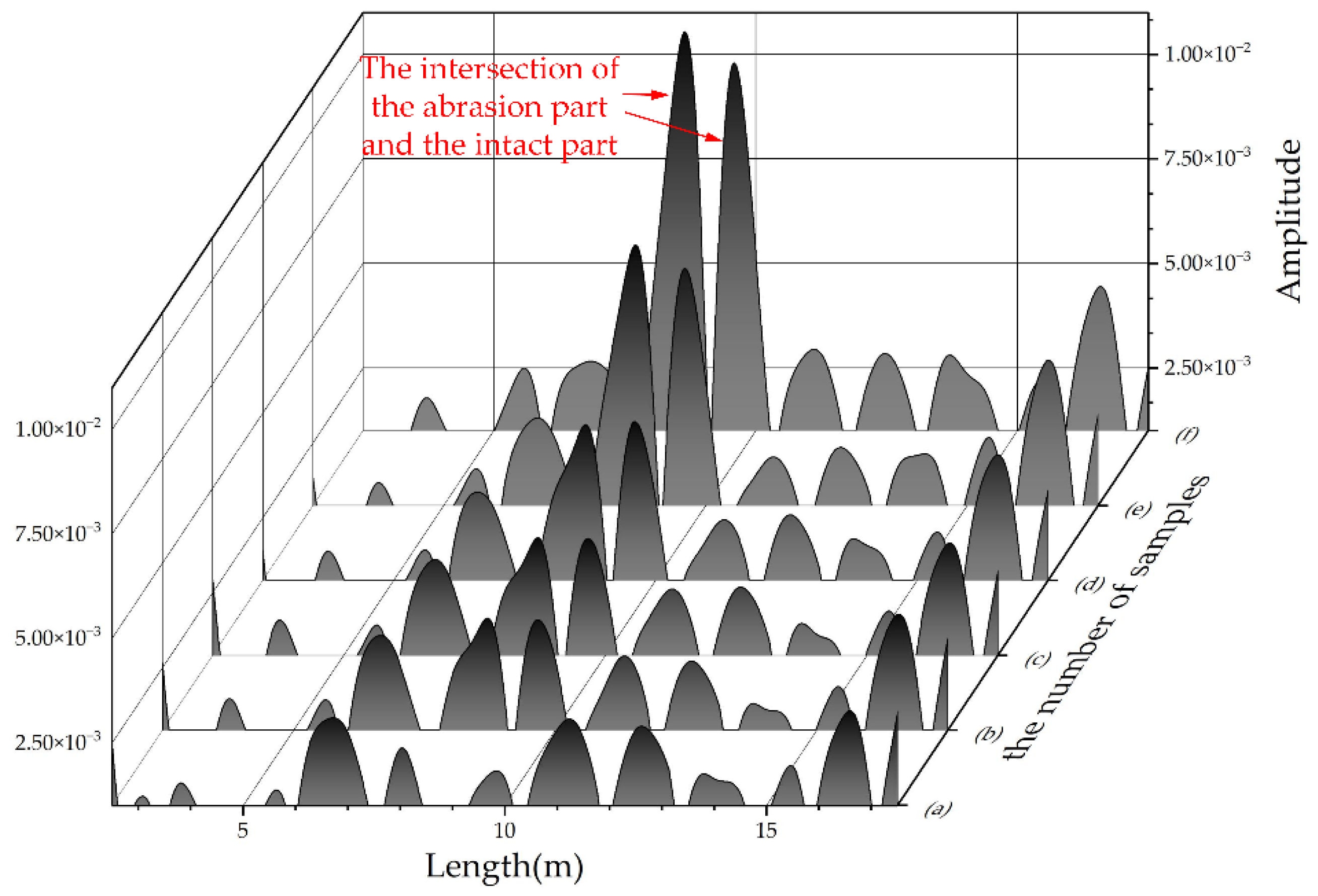
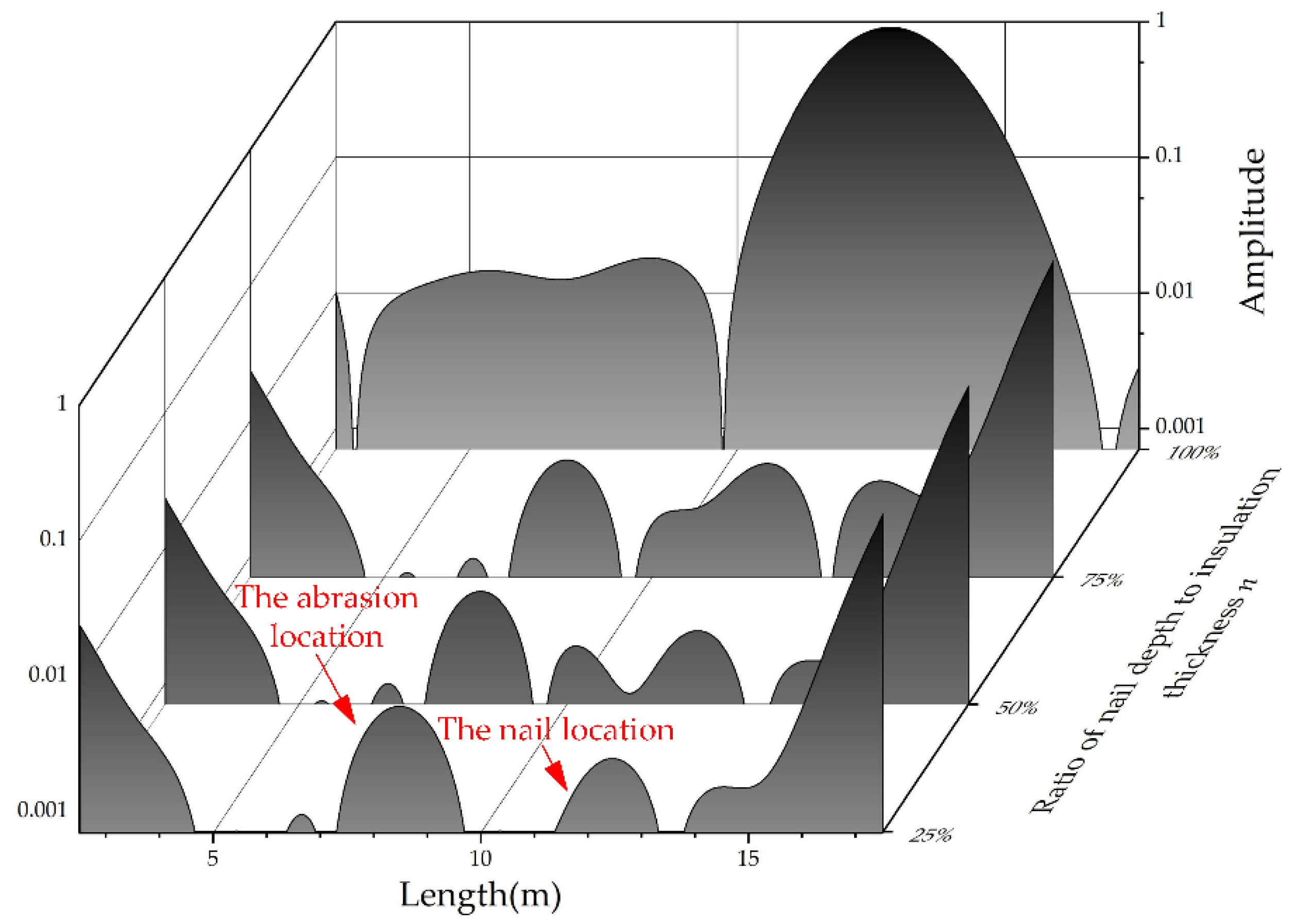
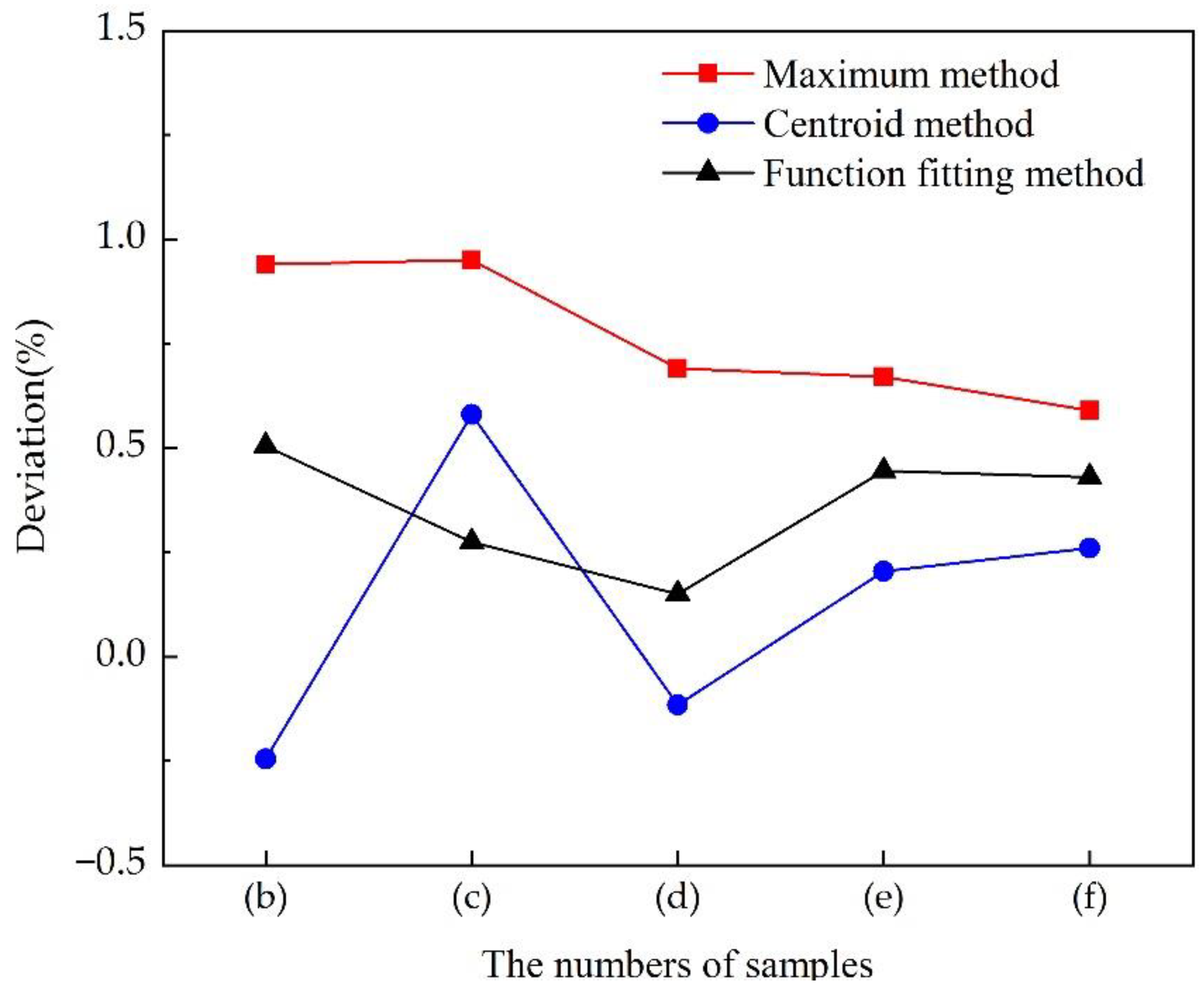
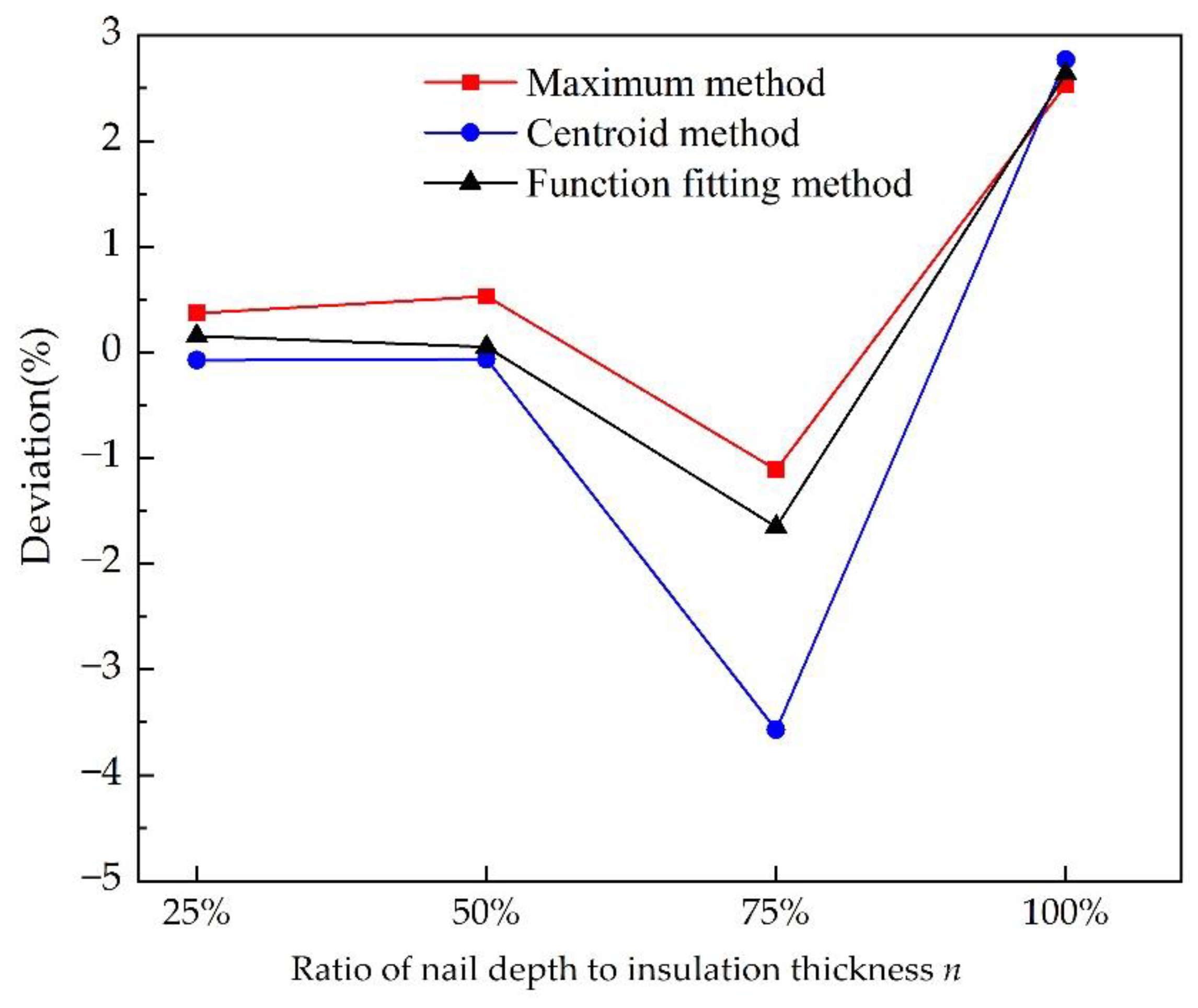
| Number | Abrasion Location (Maximum Method) (m) | Abrasion Location (Centroid Method) (m) | Abrasion Location (Function Fitting Method) (m) |
|---|---|---|---|
| (a) | — | — | — |
| (b) | 9.188 | 8.951 | 9.101 |
| (c) | 9.190 | 9.216 | 9.055 |
| (d) | 9.138 | 8.977 | 9.030 |
| (e) | 9.134 | 9.041 | 9.089 |
| (f) | 9.118 | 9.052 | 9.086 |
| Ratio of Nail Depth to Insulation Thickness n | Nail Location (Maximum Method) (m) | Nail Location (Centroid Method) (m) | Nail Location (Function Fitting Method) (m) |
|---|---|---|---|
| 25% | 12.424 | 12.335 | 12.381 |
| 50% | 12.456 | 12.337 | 12.360 |
| 75% | 12.128 | 11.636 | 12.020 |
| 100% | 12.856 | 12.904 | 12.878 |
Publisher’s Note: MDPI stays neutral with regard to jurisdictional claims in published maps and institutional affiliations. |
© 2022 by the authors. Licensee MDPI, Basel, Switzerland. This article is an open access article distributed under the terms and conditions of the Creative Commons Attribution (CC BY) license (https://creativecommons.org/licenses/by/4.0/).
Share and Cite
Wei, L.; Pang, X.; Su, J.; Han, T.; Yao, Y. Improved Locating Method for Local Defects in XLPE Cable Based on Broadband Impedance Spectrum. Energies 2022, 15, 8295. https://doi.org/10.3390/en15218295
Wei L, Pang X, Su J, Han T, Yao Y. Improved Locating Method for Local Defects in XLPE Cable Based on Broadband Impedance Spectrum. Energies. 2022; 15(21):8295. https://doi.org/10.3390/en15218295
Chicago/Turabian StyleWei, Liqiang, Xianhai Pang, Jingang Su, Tao Han, and Yufei Yao. 2022. "Improved Locating Method for Local Defects in XLPE Cable Based on Broadband Impedance Spectrum" Energies 15, no. 21: 8295. https://doi.org/10.3390/en15218295
APA StyleWei, L., Pang, X., Su, J., Han, T., & Yao, Y. (2022). Improved Locating Method for Local Defects in XLPE Cable Based on Broadband Impedance Spectrum. Energies, 15(21), 8295. https://doi.org/10.3390/en15218295






